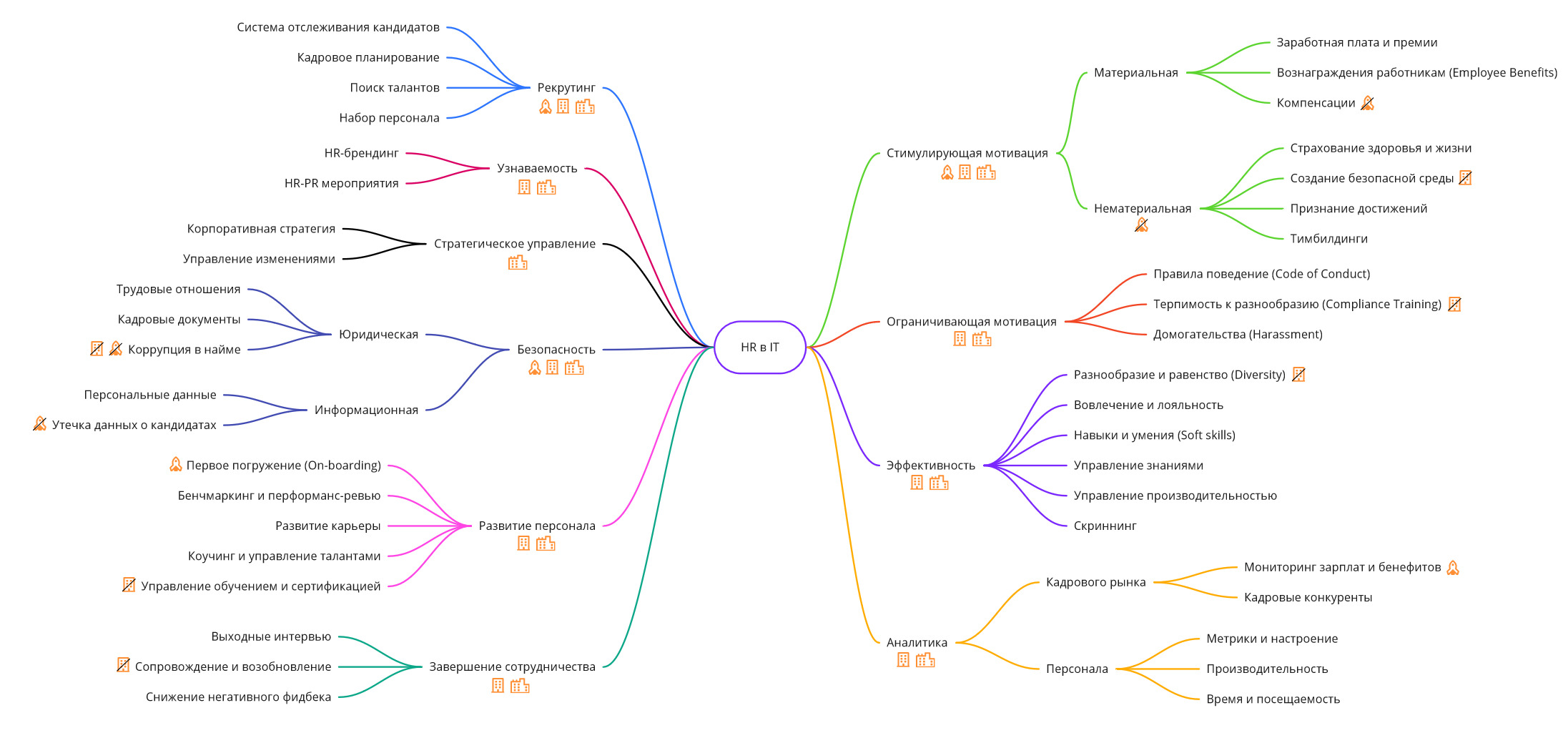“All” HR in IT on one scheme
At the top level, I got 10 areas of competence. It would be nice to have a dedicated HR for each of them. But, as a rule, this is utopia. In fact, HRs are forced to do everything at the same time. As a result, the effect is as it would be better not to take it at all.
Having tried this card on us, there was a desire to evaluate how each of the areas is suitable for companies of various business scales:
Recruiting

No matter what scale your business is, HR-CRM systems are indispensable. The market offers many cloud options (E-Staff, Hantflow, Talantix, etc.), which are quite suitable for startups. But large and medium-sized companies cannot afford even a slight risk of leakage of the most valuable in HR. Therefore, they should consider using on-premise systems.
Personnel planning should take into account the organic growth of teams. Without this, you can spoil even a good specialist by immersing yourself in a team that currently does not have the resources to train him.
To search for candidates, it is always necessary to create a clear profile so as not to waste time both the recruiter and technical specialists on obviously unsuitable candidates.
It is important to train the HR specialist in stack and interchangeable technologies in order not to miss useful specialists. Wean recruiters from the use of speech modules, as template phrases create a negative effect.
Hiring is a classic deal. Recruiter skills should include needs research, opposition work and HR brand sales.
Recognition

If you are a startup, then it makes no sense to engage in HR-branding, except that this is some kind of “fantastic unicorn”. But then your name is already well known to everyone.
Medium-sized companies have limited opportunities. If you do not want to get lost against the rest of the local market players, it is necessary to hold meetings, hackathons and other activities, including speaking at relevant conferences, creating electronic training courses, working with representatives of local IT communities, etc.
Strategic management

If these questions bother you, then most likely you already know what to do. The words Total Rewards, EVP formation and HR department resource planning are not empty words. But it is worth paying attention that with the growth of numbers, the aligned processes always break down and require transformations. There are many practices for managing corporate change for this. For example, the methodologies of Hiatt, Beckhard and Harris, Adizes and others.
Safety

Mistakes in this area are expensive, and work on volume is not the biggest. For a startup at the initial stage, it is worth attracting an outsourcer.
In distributed teams, remote signing of personnel documents adds complexity. With the advent of Article 312.2 in the Labor Code, this phenomenon has a legal basis.
About the protection of personal data is not even worth discussing. This is what bothers all IT people on earth.
Staff development

A newbie, once in your company, feels insecure. He needs to understand who he can turn to with any question (who is the official and unofficial leader, where to eat, where to get the stationery, how it is customary to communicate in a team, etc.). And also be able to prove that it is worth reckoning with. In a good way, you need to carefully conduct an excursion through all these milestones of immersion in the “new world”. But the technical staff most often does not have time for all this. Everyone has their own worries and deadlines. The key rule, if you do not want to spoil a beginner, develop an onboarding program and create a mentoring culture. Only one mentor who has a dedicated budget in the work calendar should work with the newcomer. A sufficient number of lecturers from their own and related departments should be included in the curriculum. For some positions, training and immersion lasts 3-6 months – this is a very real story, not the burning of resources. In addition, mentors also need to be taught, pedagogical talents themselves are not manifested in everyone.
After entering the role, the employee should have an understandable development model for the internal grades of the company, with regular assessments of effectiveness (at least six months) and development. If you do not make efforts to this process, you can demotivate the employee and lose control over the personnel reserve.
Completion of cooperation

For small and medium-sized businesses, “returnees” are rare. All efforts should be directed only to receiving feedback to study their own mistakes and reduce potential negative. Here you can use the exit interview and low-cost benefits to accompany an employee who has left the company (souvenirs in the DR, subscriptions to services, etc.).
Large companies need to build a career tracking system for a possible resumption of contact after a 2-3 year break.
Incentive motivation

Stimulating motivation consists of:
- Benefits (corporate events, VHI, support in difficult life situations, etc.);
- compensation (salaries, bonuses, growth opportunity, transparency);
- balance (feedback, a sense of responsibility, diversity in work, work schedule, team, autonomy, office, etc.);
- performance management (daily tasks, communications, employee understanding of the meaning of their work, atmosphere in the office, etc.).
All of the above forms a value proposition (EVP) that makes your company attractive to potential candidates.
Based on business opportunities, you can choose the most suitable options.
Limiting motivation

In a programming environment, you rarely see a skirmish or a fight, since staff are mostly introverts. It seems that in such an environment there is no place for manifestations of feelings or squabbles. But what can be read in the code review, heard on the design / planning of the sprint, retrospective is a real “storm of feelings and indignation.” If everything is left as is, the most vulnerable will periodically drop out. The easiest way to mitigate this situation is to develop, coordinate with everyone and implement a Code of Conduct in the company.
About diversion and harassment to talk in our country is not accepted. But, if you opened an office in Europe or the USA, you need to remember these risks. They can turn into a lawsuit for you on a tidy sum or irreparable damage to your reputation. In product management, “diversity of personnel” really allows you to take into account the interests of the entire multifaceted audience.
Efficiency

The effectiveness of the HR department for recruitment consists of the competent management of the accumulated knowledge and soft skills of employees. In addition to internal efficiency, with our decisions we influence the effectiveness of the company as a whole.
How can HR affect performance? After all, there are product and technical managers for this. But often, in interactions within teams and at their junctions, there are huge areas of darkness for which no one wants to answer. In addition, each team has its own microclimate and temperament. Therefore, it is important, before a new person comes to the team, to think about psychological compatibility and include in the initial requirements for selecting a position.
Team building and loyalty cannot be raised. Of course, corporate events are a mandatory minimum of any normal company. But the most basic thing that we can do is to enforce the rule: a team will be friendly and effective only if it has 50% + 1 “right employees”. Then they will cope.
Analytics

In a start-up environment, the only way to attract candidates is to pay above the market, to attract freedom of technology choice and managerial flexibility. Analysis of competitors and the personnel market will not bring significant results.
For everyone else, compiling knowledge about the status of all competitors and their EVP is a mandatory requirement. For each company with a similar technological stack, you can keep a dossier, monitor their successes and failures. Track trends in the RFP in the context of the necessary specialists.
Mandatory practice is to introduce 360 ° polls, retrospectives of the quality of managers’ feedback to employees for performance reviews, regular assessments of satisfaction with working conditions, processes and technologies (anonymous polls, face-to-face conversations).
In the case of a distributed team, the use of time-tracking systems and hourly pay are often found. This causes a negative for most employees.
Even if you have a culture of agile development and a high level of engagement, you need to have ways to identify employees who have dropped out of the process to avoid unnecessary expenses. To do this, you can use many indirect features, including accounting data and information systems.
Conclusion
One article is difficult to cover the entire field of HR in IT. But I hope that my cursory glance at the main aspects will help me deal with the questions that you “put off until later.” Started in the repository github.com/Uliarimsha/IT-HR, pool requests with concise disclosure of topics and links to sources are welcome.






